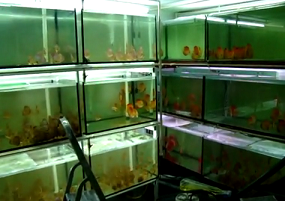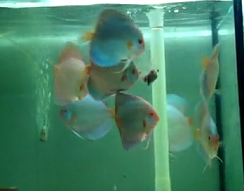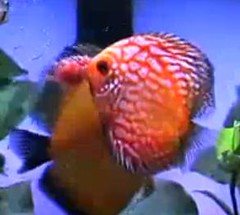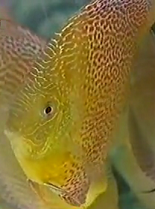 Sometimes it can be quite difficult to segregate the different strains and variants of different types of discus fish into its own grouping because there are times certain characteristics may overlap with each other. Listed below, is the list of all strains which I’ve so far come across and described in details. Hopefully it can be used as a guide when identifying your discus fish.
Sometimes it can be quite difficult to segregate the different strains and variants of different types of discus fish into its own grouping because there are times certain characteristics may overlap with each other. Listed below, is the list of all strains which I’ve so far come across and described in details. Hopefully it can be used as a guide when identifying your discus fish.
Wild Discus (natural surviving discus found in the wild and it’s the pure strain without having undergone cross-breeding)
Alenquer – solid orange or brown on the whole body while the fin is slightly bluish in color with some pattern. There are other variants that even have some slight marking that also shows on the body as well. At times, you can notice vertical band appearing cutting across the body. Can be further sub-divided into smaller groups with common characteristics such as the Curipera and Jaraki.
Red spotted screen – Unlike the cross-bred spotted discus, this wild variant has less spotted marking which is appears to be light-toned. Often confused with the Red leopards.
Turquoise – Blue to light blue in color with distinctive pattern on its body.
Heckel – Obvious vertical black color band seen on the body. Generally light brown in color and requires a slightly acidic water to survive. Experienced discus breeder will even complain how hard it is to maintain and kept the fish alive without getting stunted. Mostly found close to riverbanks and depending on the location in which they are caught, the color intensity can vary. It is by far one of the most susceptible to common discus fish diseases.
Blue Discus
Giant Flora – High and wide body appearance with clear blue color floral pattern.
Blue Diamond or Golden Blue Diamond – has strong solid blue color without any marking on its body. The discus fish in healthy state will turn to bright blue color and when the fish is kept in a fluorescent tank, the color can turn into reflective state showing the magnificent display of color.
Cobalt Blue – Closely resembles the blue diamond but the color tone is lighter
Flachen – The most common type of discus with bluish green body. Can easily turn to dark blue black color if the fish is under stress
Striped Turquoise – Refer to turquoise described in the Wild discus section
Red Discus
Checkerboard – Red color random clear pattern displayed on a white body. At one time, during its early introduction, the fish can easily fetch thousands of dollars.
Melon – Dark striking orangey red without any pattern on its body. Easily recognized due to its bright coloration
Red golden diamond – Looks almost like the melon but it has lighter shade appearing on the belly of the fish
Red Scribble – has a vertical band cut across its eye and it appears the same for all fish that falls under this group. It has the same red color pattern or marking found on a checkerboard but it appears on a blue background.
Red Turquoise
Rose Red – Plain body just like the melon discus but however, what makes this fish different is that the red appears to be dark strong color.
Yellow Discus
Yellow Crystal – Not exactly yellow in nature but the tone appears in slight orangey yellow. Almost plain without any marking.
Albino golden – As implies by its name, the discus is the albino type with slight yellowish color with red eyes. Nothing special in this one but certain hobbyists seem to like it very much.
Pigeon Blood (with its distinctive pattern, this discus type can be easily characterized and identified and is highly sought after by discus hobbyist)
Pigeon leopard snakeskin
Pigeon Checkerboard
Pearl Pigeon or Panda Pigeon – Looks very much similar like the checkerboard. Experienced hobbyist has decided to segregate the fish into its own grouping.
White Butterfly or White dragon – Off white appearance with marking appearing just on the gills of the discus fish. To me, it is not the type that would be described as colorful.
Spotted Discus (is one of the most sought after because of its beauty. As the name implies, it has a marvelous well formed leopard spot distributed on its body)
Ring Leopard – Sometimes called the red leopards, it is the most famous discus variant in its group. It has small, highly scattered multiple spots appearing all over the body. Most common is the red variant but blue type can also be found in the aquarium trade.
Leopard Spotted – The only one which I’ve seen before is the deep-bodied, red color spotted marking.
Golden Leopard
Snakeskin (Just like the pigeon blood, the marking on a snakeskin is generally characterized by its blue color pattern formed on a light tone background)
Brown Snakeskin
Blue Snakeskin
Penang eruption
Fire Ruby – Looks more like the Rose Red Discus but it has more light shades of color tones.
Misc (not grouped into any of the groupings mentioned above)
Nebula, better known as Calico – Combination of yellow and white shades on its body. Believed to be a cross-bred fish between the albino and the yellow type discus. Not the kind that really commands high price in the sale and export market.
Snow White or White Diamond – Almost whitish in color. The discus is best described as having the off-white light pink coloration. Plain and dull-looking.
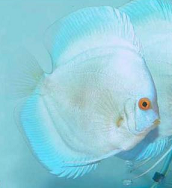 I always believe that food is the most important factor that ensures discus fish success. While water quality is as critical so as to keep them alive but sometimes your fish might not be that fussy after all. Usually if you have money and cash to spend, investing towards getting a proper high end water filter that removes chlorine, harmful chemicals is just more than enough to ensure that the water is suitable for your discus pet.
I always believe that food is the most important factor that ensures discus fish success. While water quality is as critical so as to keep them alive but sometimes your fish might not be that fussy after all. Usually if you have money and cash to spend, investing towards getting a proper high end water filter that removes chlorine, harmful chemicals is just more than enough to ensure that the water is suitable for your discus pet.


 Posted by discusfishplace
Posted by discusfishplace 
